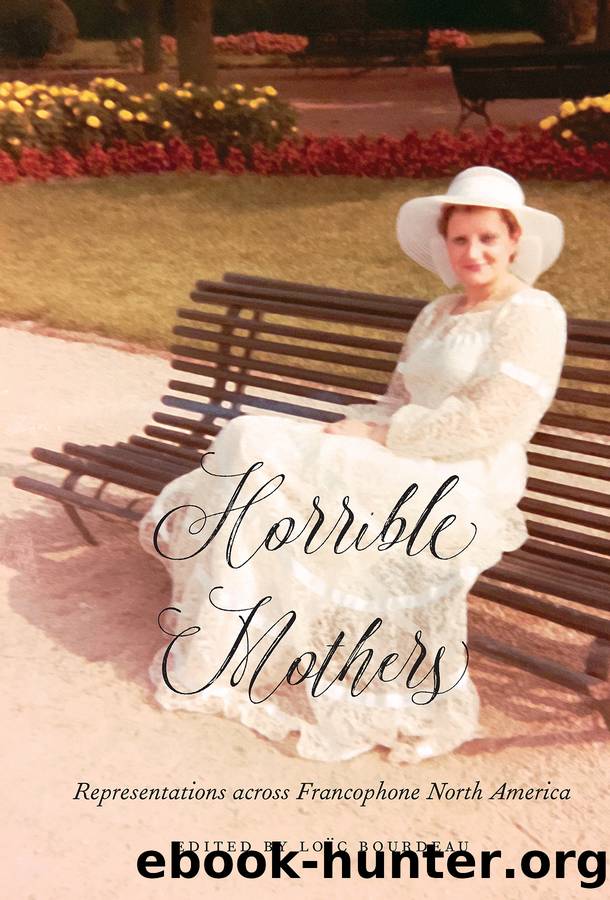Horrible Mothers by Unknown

Author:Unknown
Language: eng
Format: epub
Tags: SOC052000 Social Science / Media Studies
Publisher: University of Nebraska Press
6
Voicing Shame
From Fiction to Confession in the Work of Marguerite Andersen
Lucie Hotte and Ariane Brun del Re
Nearly every mother has at one time or another felt unequal to her task. This feeling of being a bad mother surfaces whenever a woman is unable to meet societyâs expectations of her as a mother. Indeed, since the eighteenth century, our relationship to motherhood has evolved (see Badinter) and has led to the romanticization of motherhood, which âhas divided mothers into the categories of either the naturally good or pathologically bad. This has meant that mothers felt an exaggerated guilt over the slightest feeling of aggression or impulse toward violence against their childrenâ (Lachance Adams 12).
Although loving and devoted to their children, mothers must nevertheless consider their own needs. The tension between the needs of their children and their own has resulted in what many researchersâpsychologists and philosophers alikeâcall âmaternal ambivalence,â that is, âmothersâ simultaneous desires to nurture and violently reject their childrenâ (Lachance Adams 4). While it is true that not all mothers will violently reject their children, it is nonetheless a fact that this feeling of ambivalence, which âresults from the motherâs efforts to achieve both intimacy and separation in relation to their childrenâ is more common than most women would dare confess (4). How might one express the shame and guilt that haunt women who embrace their own needs to the real or imagined detriment of their childrenâs well-being?
The work of Franco-Ontarian writer Marguerite Andersen, inspired by her own life, seeks a way to express this shame and guilt.1 These two emotions, which are the driving force behind her work, have various origins: Nazism and her German citizenship, her unfettered sexuality, and her relationships to her mother and to her children. The latter source of shame will be the subject of our analysis of the literary genres Andersen uses. We will begin with an introduction to Andersenâs work and her use of different literary genres, from her first novel, De mémoire de femme (1982), subtitled Récit en partie autobiographique, to her most recent, La mauvaise mère (2013), labeled as âconfessions.â2 We argue that this progression from fiction to confession allows the writer to finally declare her failings as a mother. To support this claim, we will analyze the ways in which she recounts her negligence toward her children, especially her sons. This literary analysis will reveal her self-imposed inability to see her performance of motherhood as equal to that of her motherâs. Writing thus becomes a means to confess, to seek exoneration, and to do penance.
Download
This site does not store any files on its server. We only index and link to content provided by other sites. Please contact the content providers to delete copyright contents if any and email us, we'll remove relevant links or contents immediately.
The Girls I've Been by Tess Sharpe(1209)
Firekeeper's Daughter by Angeline Boulley(1134)
21st Birthday (Women's Murder Club) by James Patterson(1107)
I Think I Love You by Auriane Desombre(1059)
Harry Potter and the Sorcerer's Stone by Rowling J K(1058)
Harry Potter 01 - Harry Potter and the Sorcerer's Stone by J.K. Rowling(1022)
Let's Talk About Hard Things by Anna Sale(938)
The Lion King by Disney Book Group(925)
Perfect Illusion by Claudia Tan(906)
Flamefall by Rosaria Munda(848)
You Are Awesome by Neil Pasricha(795)
The Montessori Baby by Simone Davies(779)
You'd Be Home Now by Kathleen Glasgow(727)
Time To Go by Time To Go (epub)(700)
A Pho Love Story by Loan Le(693)
Pax, Journey Home by Sara Pennypacker(659)
Aristotle and Dante Discover the Secrets of the Universe by Sáenz Benjamin Alire(634)
Yolk by Mary H. K. Choi(623)
Sandwiches! by Alison Deering(610)
